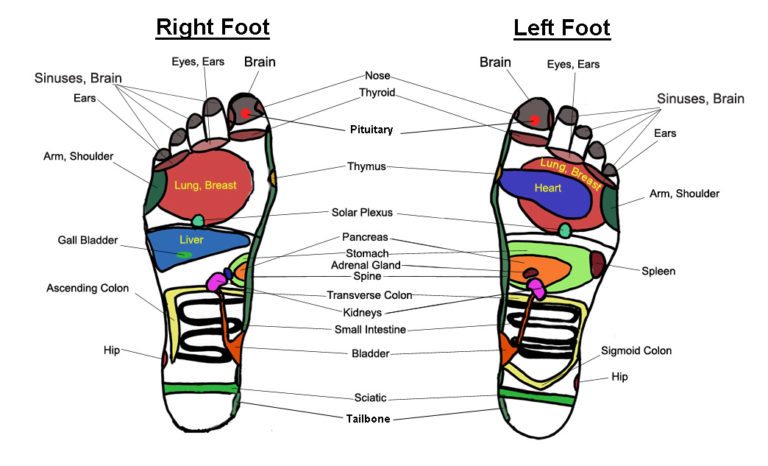
Reflexology is an alternative medicine system that claims to treat internal organs by pressing on designated spots on the feet and hands; there is no anatomical connection between those organs and those spots. Systematic reviews in 2009 and 2011 found no convincing evidence that reflexology is an effective treatment for any medical condition. Quackwatch and the NCAHF agree that reflexology is a form of massage that may help patients relax and feel better temporarily, but that has no other health benefits. Our own Mark Crislip said, “The great majority of studies demonstrate reflexology had no effects that could not be replicated by picking fleas off your mate…And it has no anatomic or physiologic justification.”
We recently received an email from a representative of Modern Reflexology asking if they could advertise their website on ours and offering to pay. Of course, we don’t accept advertising. But I was puzzled as to why they approached us and what they thought was science-based about reflexology. I was intrigued enough to visit their website to learn what “modern” reflexology was all about. I learned about a lot of specific claims I hadn’t heard before, but I found no science whatsoever. By writing this article, I am in a sense giving them the advertising that they asked for; but it will be negative publicity, not positive. Old adage: Don’t wish too hard for what you want; you might get it.
Reflexology or acupuncture?
Their website seems to conflate reflexology with acupuncture and acupressure. There are five tabs at the top of the home page: (1) Store, which links to a single Amazon.com page selling a reflexology foot massager, (2) Acupressure Points and (3) Reflexology Treatment, both of which have multiple articles on acupuncture and acupressure, (4) Reflexology Machines – foot massagers and acupressure mats, and (5) Courses. Notable by its absence is a tab for scientific studies showing that any of this stuff works.
There are articles on “Learn the Importance of Five Elements Theory in Acupressure – Dao, Yin Yang,” how acupuncture is effective for smoking cessation; why acupuncture is a form of preventive medicine; how acupuncture treats various skin conditions, seasonal allergies, emphysema, hemorrhoids, gallbladder disorders, and emotional syndromes; the healing effects of Qi in acupuncture; the Five Spirits that impact mental health (Hun, Shen, Yi, Zhi, and Po); and on and on.
Claims for specific conditions
Detoxification: 7 best acupressure points for complete detoxification of the body include the Great Rushing point on the webbing between the big and second toes, the Three Yin Crossing on the ankle, the Shu Mansion just below the collarbone, Union Valley on the hand, Inner Gate on the arm, Upper Sea of Qi on the sternum, and Lower Sea of Qi below the umbilicus. They claim that pressing on these points will flush out toxins, improve the immune system, reduce weight, prevent chronic diseases, and improve mental clarity.
Asthma: They say that pressing on 8 acupressure points on the collarbone, sternum, shoulder, thumb, wrist, and fingers will stimulate oxygen in the body and prevent asthma-related deaths.
Better eyesight: They claim that 7 acupressure points have been successful in treating short- and long-sightedness, cataract, glaucoma, presbyopia, astigmatism, amblyopia, diploma (I think they mean diplopia, double vision), color blindness, night blindness and many other eye disorders.
Diabetes: 6 points specified. One of them: “Place your fingers 2 centimeters below the knee, as shown in the picture. Massage this area with a little pressure for 5 minutes every day. It balances the digestive system. Diabetes is said to begin with stomach fire and proper digestion can reduce this problem. You will immediately see the result. This method is also used to prevent aging, arthritis and other forms of weaknesses.”
Hair loss: Massaging several acupressure points will “stimulate and energize the nerves that are causing the problem.” The Paihui is important. “The Paihui is located right in the middle of your scalp. Most of the pressure points related to the hair re-growth are present near this area. Take ten toothpicks and wrap them in a rubber band. Use them to gently poke the paihui, be very careful not to hurt yourself. This action improves the blood circulation in the scalp, which reduces hair fall.”
That’s enough to give you an idea of their claims. The website has many similar claims for other specific effects of acupressure and acupuncture.
What are these points?
A rose by any other name…Whether these are reflexology points or acupuncture points or acupressure points, there is nothing to suggest that they have any existence in anatomic or physiologic reality. How could these points have been determined to represent internal organs? Not by any controlled studies, but by uncontrolled imagination.
And there is no credible evidence that pressing on those points benefits health. The website is larded with terminology from acupuncture mythology and with unsupported claims for therapeutic applications. It’s obvious that none of this has anything to do with science. It is a belief system, and a rather confused one at that.
Conclusion: Whether ancient or modern, reflexology is still bogus
Christopher Hitchens famously said, “What can be asserted without evidence can be dismissed without evidence.” I dismiss reflexology. In my opinion, it is a theatrical placebo with a soupçon of relaxing massage.

